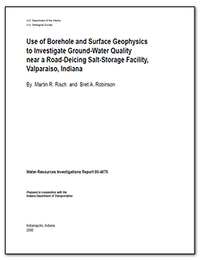Use of borehole and surface geophysics to investigate ground-water quality near a road-deicing salt-storage facility, Valparaiso, Indiana
Links
- Document: Report (4.04 MB pdf)
- Download citation as: RIS | Dublin Core
Abstract
Borehole and surface geophysics were used to investigate ground-water quality affected by a road-deicing salt-storage facility located near a public water-supply well field. From 1994 through 1998, borehole geophysical logs were made in an existing network of monitoring wells completed near the bottom of a thick sand aquifer. Logs of natural gamma activity indicated a uniform and negligible contribution of clay to the electromagnetic conductivity of the aquifer so that the logs of electromagnetic conductivity primarily measured the amount of dissolved solids in the ground water near the wells. Electromagnetic-conductivity data indicated the presence of a saltwater plume near the bottom of the aquifer. Increases in electromagnetic conductivity, observed from sequential logging of wells, indicated the saltwater plume had moved north about 60 to 100 feet per year between 1994 and 1998. These rates were consistent with estimates of horizontal ground-water flow based on velocity calculations made with hydrologic data from the study area.
Ratios of chloride to bromide concentrations in water samples were used to distinguish sources of chloride in the ground water?whether from road-deicing salt, domestic wastewater, or natural occurrences. Water samples identified with the chloride/bromide ratios as being affected by road-deicing salt had concentrations of dissolved solids, chloride, and sodium many times the background levels for the study area. The largest concentrations were in water from wells near the salt-storage facility?12,400 to 12,800 milligrams per liter (mg/L) dissolved solids, 6,730 to 7,230 mg/L chloride, and 3,690 to 4,400 mg/L sodium.
A conceptual, multi-layer model was developed to describe the vertical extent of the saltwater plume in the vicinity of the monitoring wells. A relation was derived between average borehole electromagnetic conductivity in the screened interval of the wells in the saltwater plume and concentrations of dissolved solids in water samples from those wells. This relation was used in the model to show borehole electromagnetic conductivity in transects of wells as a zone of saline water overlain by zones of brackish water and freshwater. The thickness and altitude of the zones of saline and brackish water decreased with increased distance from the salt-storage facility.
Two surface surveys of terrain electromagnetic conductivity were used to map the horizontal extent of the saltwater plume in areas without monitoring wells. Background values of terrain conductivity were measured in an area where water-quality and borehole geophysical data did not indicate saline or brackish water. Based on a guideline from previous case studies, the boundaries of the saltwater plume were mapped where terrain conductivity was 1.5 times background. The extent of the saltwater plume, based on terrain conductivity, generally was consistent with the available water-quality and borehole electromagnetic-conductivity data and with directions of ground-water flow determined from water-level altitudes.
Suggested Citation
Risch, M., Robinson, B., 2001, Use of borehole and surface geophysics to investigate ground-water quality near a road-deicing salt-storage facility, Valparaiso, Indiana: U.S. Geological Survey Water-Resources Investigations Report 2000–4070, Report: vi, 63 p., https://doi.org/10.3133/wri004070.
Study Area
Table of Contents
- Abstract
- Introduction
- Physical and Hydrogeologic Setting
- Methods of Investigation
- Ground-Water Quality
- Geophysical Investigations
- Summary and Conclusions
- References
- Appendixes
| Publication type | Report |
|---|---|
| Publication Subtype | USGS Numbered Series |
| Title | Use of borehole and surface geophysics to investigate ground-water quality near a road-deicing salt-storage facility, Valparaiso, Indiana |
| Series title | Water-Resources Investigations Report |
| Series number | 2000–4070 |
| DOI | 10.3133/wri004070 |
| Year Published | 2001 |
| Language | English |
| Publisher | U.S. Geological Survey |
| Publisher location | Indianapolis, IN |
| Contributing office(s) | Indiana Water Science Center |
| Description | Report: vi, 63 p. |
| Country | United States |
| State | Indiana |
| County | Porter County |
| City | Valparaiso |
| Online Only (Y/N) | Y |
| Additional Online Files (Y/N) | N |


